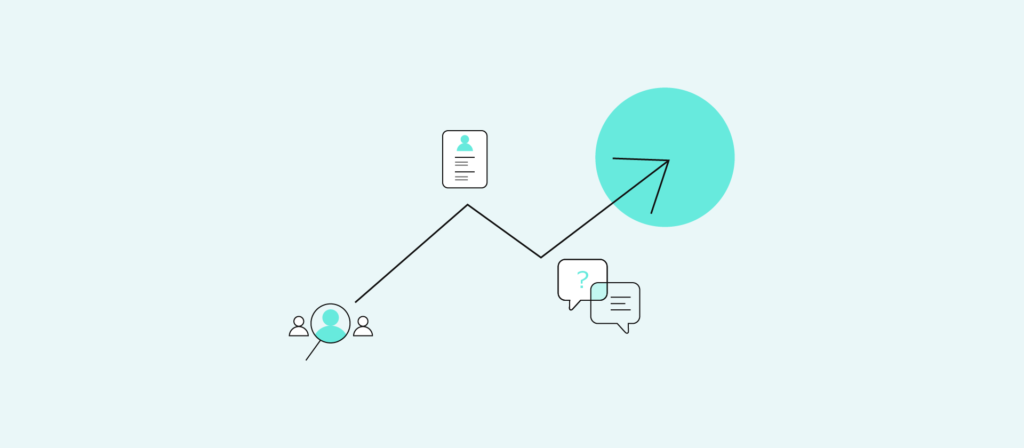It takes 24 days, on average, to successfully recruit and hire someone in the U.S.
Though the number might seem high, it’s easy to grasp as you break down your recruitment process: candidates need to be sourced; resumes need to be analyzed; interviews need to get scheduled, etc.
As organizations of all shapes and sizes look for ways to improve their recruitment and hiring efforts, they’ll increasingly turn to automations. Once implemented, these recruiting automations should save employees time, deliver better candidate experiences, and ultimately help the organization scale its workforce efficiently.
So, what kinds of automations will organizations look to adopt? We’ll help answer this question by walking you through 3 recruitment automation trends.
Related: 3 automation trends to look out for in 2022
1. Recruiters will streamline candidate screening
The process of analyzing resumes and deciding which candidates to interview can be grueling. In fact, screening a single candidate can take as long as 23 hours.
As recruiters look to identify the best talent in less time and focus more on engaging with target candidates instead, they’ll rely on automation.
More specifically, they’ll automate resume screening by doing something like the following:
1. An applicant fills out the job application form.
2. A chatbot reviews the candidate’s profile, keeping specific skills in mind as they look over it.
3. If the candidate’s application passes the predetermined criteria, the chatbot messages a specific channel in your business communications platform, where recruiters can view the candidate and access the link to their application.
If the candidate, on the other hand, doesn’t meet the criteria, the chatbot can automatically reject them in your recruiting app.
Related: IT automation trends you need to know about
2. Employees will be able to refer candidates in just a few clicks
When it comes to identifying the best candidates, your recruiters need the team at large to chip in. Why? Because research shows that referrals often lead to better hires for the business.
To encourage employees to actually submit referrals over time, recruiters will use an automation that allows anyone to submit them within their business communications platform. Here’s more on how it can work:
1. An employee accesses the chatbot within their business communications platform, and types a command, like “add new referral.”
2. The chatbot opens a modal where the employee can enter the candidate’s name, email, Linkedin profile, etc.
3. Once submitted, the chatbot instantly adds the candidate’s profile to your recruiting app. At the same time, the chatbot also messages the recruiter, alerting them of the referral and allowing them to forward the candidate along to the hiring manager with the click of a button.
Related: A guide to automating talent sourcing
3. Interviewers will receive timely messages that help facilitate their interviews
No matter how successful your recruiters are at sourcing talent and moving them forward in the interview process, a poor interview experience can be all it takes to dissuade the candidate from moving forward.
A poor interview experience can even lead your organization to lose a potential client down the road: Nearly two thirds of candidates say they wouldn’t buy a company’s products or services after going through an unpleasant interview experience with the organization.
To help prevent several negative outcomes from taking place— such as the interviewer showing up late or preparing inadequately—, recruiters and hiring managers will lean on the following automation when interviewing remotely:
1. Once an interview is scheduled in your recruiting app, a chatbot creates a channel in your business communications platform that includes all of the interviewers.
Within that channel, interviewers can find the interview schedule, and a link to the candidate’s profile in the recruiting app.
2. Once the first interview is just 5 minutes away, the chatbot alerts the group, reminds channel members of the schedule, and re-shares the link to the candidate’s application.
3. As each interviewer finishes, the chatbot asks them to fill out the scorecard in your recruiting app. At the same time, the chatbot notifies the next interviewer that it’s their turn, and it shares the link for them to join the interview.
4. After all the interviewers finish speaking with the candidate, the chatbot messages the entire group, asking them to sync on the candidate using a newly provided link.
Related: 5 HR automation trends to keep an eye on
Stay on top of recruitment automation trends by adopting Workbot
Workbot, Workato’s enterprise chatbot, can help power these recruitment automation trends, regardless of whether your team uses Slack, Teams, or Facebook Workplace as its business communications platform.
To learn more about Workbot, and to uncover all the use cases it can provide at your organization, you can speak with one of our automation advisors.
